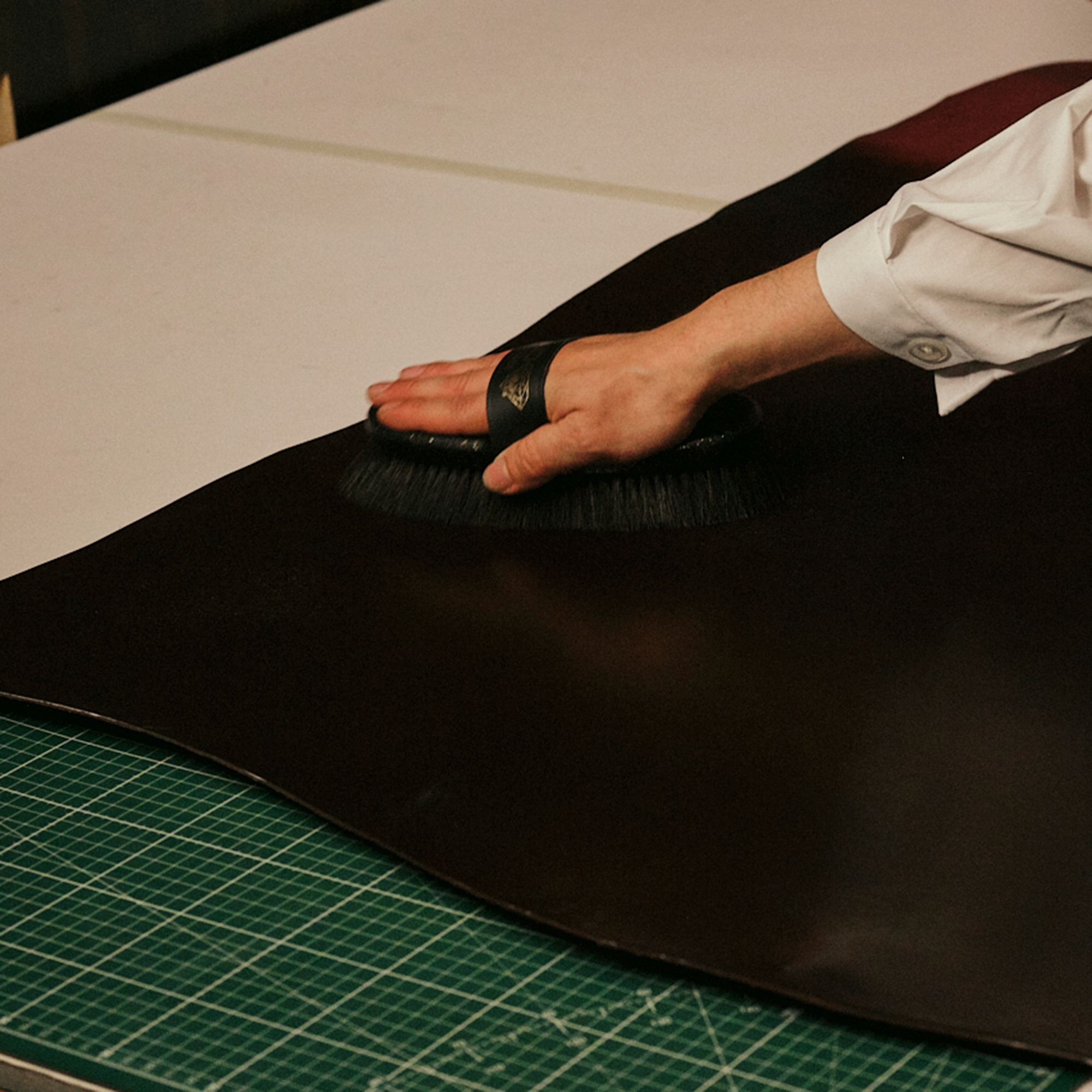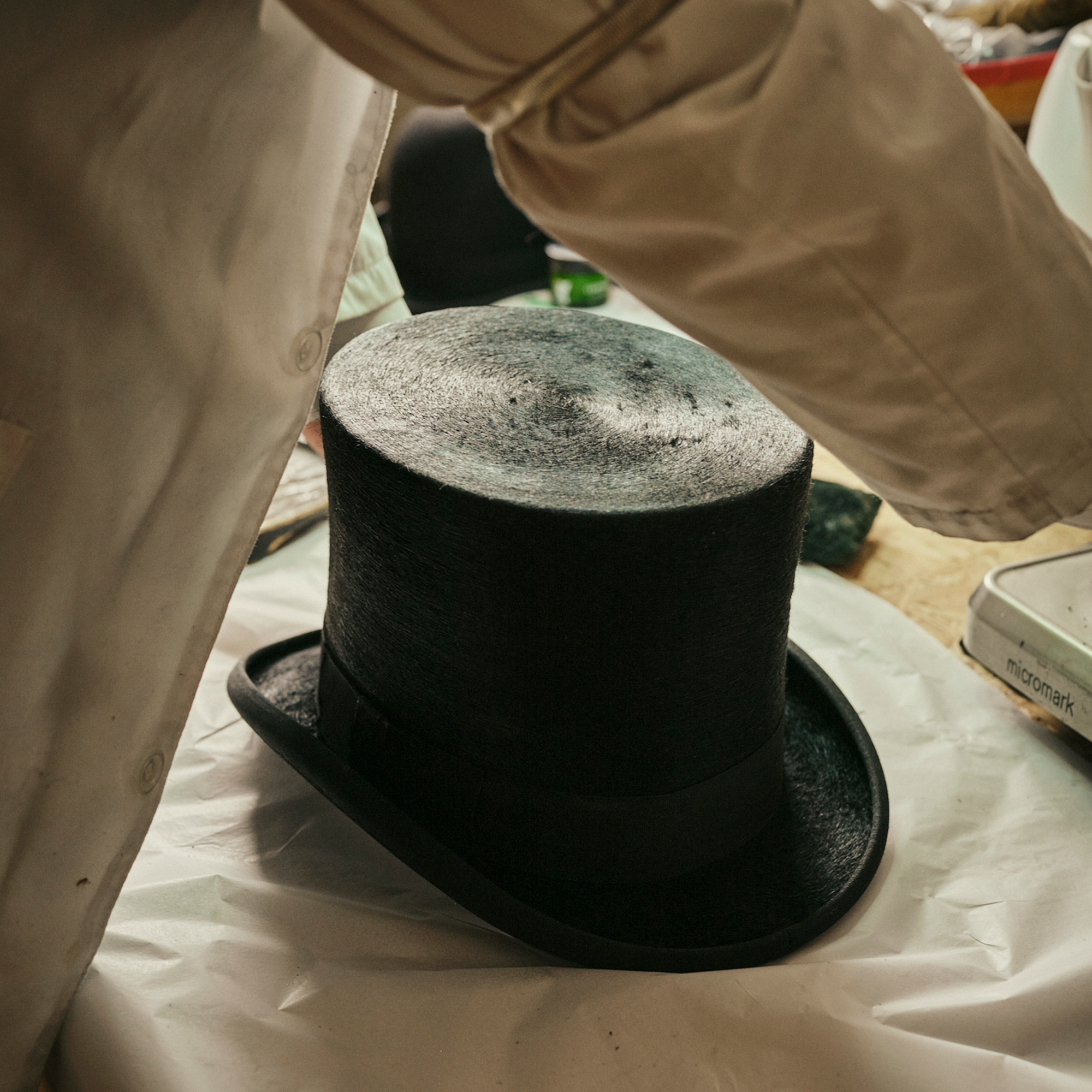HERBERT JOHNSON HEADWEAR
CARE GUIDE

CARE ADVICE FOR
FUR FELT HEADWEAR
CARE: Avoid handling your hat by the crown as you could wear out the front pinch. Holding your hat by the brim is the best way to handle any hat. We advise against wearing your hat in heavy rain. If your fur felt hat does get wet, shake off any excess water and allow to dry naturally placed brim faced down at room temperature. Never force dry your hat using any form of heat source. If required, use your hands to gently reinforce the shaping of the crown and brim. When completely dry, lightly brush to clean.
CLEANING: Use a soft bristled hat brush (available in store or online soon). Brush the hat counter-clockwise. Gently steaming and brushing your fur felt can help lift marks from the felt. For more advanced cleaning needs and repair work, please consult your hatter.
STORAGE: Storing your hat in a hat box prevents dust from accumulating on the fur felt and provides protection from sun damage and from being crushed. Storing your hat with a hat-jack or mould inside that approximates your head size/shape can be a useful way to store your hat and allow it to further conform to your head shape whilst not in use. Never leave your hat in a hot car as this can fade the felt & ribbon and can also age the leather sweatband.

CARE ADVICE FOR
WOOL FELT HEADWEAR
CARE: We advise against wearing your hat in moist weather conditions as this may leave the hat vulnerable to shrinkage or loss of shape. If your wool felt hat does get wet, shake off any excess water and allow to dry naturally placed brim faced down at room temperature. Never force dry your hat using any form of heat source. Consider wearing the hat or using a hat-jack whilst the hat is drying to help prevent any reduction in size. If required, use your hands to gently reinforce the shaping of the crown and brim. Avoid handling your hat by the crown as you could wear out the front pinch. Holding your hat by the brim is the best way to handle any hat.
CLEANING: care instructions for the treatment of wool should be followed. We recommend against brushing your hat as this can cause pilling of the wool fabric. A soft cloth can be used to gently remove any dust or minor particles from the fabric.
STORAGE: Storing your hat in a hat box prevents dust from accumulating on the felt, provides protection from sun damage and from being crushed. Storing your hat with a hat-jack or mould inside that approximates your head size/shape can be a useful way to store your hat and allow it to further conform to your head shape whilst not in use. Using some form of safe moth repellent inside the hat box whilst in storage is recommended. Never leave your hat in a hot car as this can fade the felt & ribbon and can also age the leather sweatband.

CARE ADVICE FOR
STRAWS AND PANAMAS
CARE: Take care when handling as this risks breaking the delicate straw fibres. Avoid handling your hat by the crown or front pinch. Holding your hat by the brim is the best way to handle any hat.
CLEANING STRAWS: Dirt or marks should first be cleaned with a dry, soft, lint-free cloth to prevent catching or snagging. If any marks persist, try cleaning with a moist baby-wipe or mild soap and water. Care should be taken not to rub too hard. The use of any cleaning detergents are not recommended.
STORAGE: Store your hat somewhere cool and dry, preferably in a hat box. Storing your hat in a hat box prevents dust from accumulating on it, provides protection from sun damage and from being crushed. Do not stack with other hats. We recommend using a hat jack to help retain the hats shape. Never leave your hat in a hot car as this can dry out the straw, fade the ribbon and can also age the leather sweatband. If your hat gets wet, leave it to dry naturally. In the case of any damage or loss of shape sustained by mishandling, then please contact your hatter for help and advice.

CARE ADVICE FOR
wool and tweed woven fabric headwear
CARE: Only care instructions for the treatment of wool/tweed fabrics should be followed. We recommend against brushing your hat as this can cause pilling of the fabric.
CLEANING: A soft cloth can be used to gently remove any dust or minor particles from the fabric. We advise against allowing your wool cap to become wet as the fabric may be vulnerable to shrinkage. Caps are not suitable for machine washing and this can cause irreparable damage to the hats components and structure!
STORAGE: We recommend that you store your cap somewhere dry placed peak side down. For longer periods of storage, we recommend keeping your wool cap in a hat box including some form of moth-repellent.

CARE ADVICE FOR
leather products and components
CARE: Leather feed can be used to condition leather products and components, helping to maintain the leathers suppleness and longevity. Swaine Leather Feed is available in store or online.
CLEANING: We recommend using a soft lint free cloth to clean any minor dust or dirt from the surface of the leather. Try using a damp baby-wipe for any more stubborn marks but take care not to overwork it or rub too hard.
STORAGE: When not in use, store your leather product somewhere cool, dry and out of direct sunlight.

CARE ADVICE FOR
TOP HATS AND BOWLERS
CARE: Hard felt headwear such as top hats and bowlers require care and attention after every use. Herbert Johnson offers professional services to assist you in the upkeep of your hats to keep them looking their best.
CLEANING: We recommend the use of a soft bristled hat brush in an anticlockwise direction. This can be followed by a fine mist of fresh water and the use of a damp velvet polishing pad to achieve a smooth finish.
STORAGE: Store your hat somewhere dry away from direct sunlight. We recommend storing your hard felt hat in a hat box to protect it whilst not in use.

specialist repairs and restoration
The historic hatter Herbert Johnson exercises the utmost care in processing headwear, whether cleaning, blocking, or repairing your hat will undergo an in-depth assessment and outline any concerns or options for approval before the commencement of restorative work.















